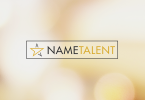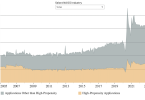Sales data can help inform what is prudent to hold in your domain portfolio. It can also guide your business plan. In this report I look at what has sold in the world of new domain extensions over the past month, and what actionable items we can extract from that analysis.
On my personal blog each month I take a look at the previous 30 days of NameBio announced new global top level domain (ngTLD) sales. You can find the most recent report here (it covers the period Sept. 23 – Oct. 22, 2018). In this NameTalent post I wanted to look more carefully at what the analysis may mean for new extension domain investors. In particular I identify the types of names you should invest in, where you might consider listing them, and reflections on the biggest question of all, whether you should invest in ngTLDs.
Summary
Here is the summary from the most recent monthly sales report.
- 67 NameBio recorded ngTLD sales in the 30 day period, with $180,800 total sale volume.
- The average sales price was $2955. The median price was $801.
- In terms of major sales, 1 was for more than $50,000, 8 were above $5000 and 29 of the sales were for $1000 or more.
- Sales in 22 different extensions took place, with .top, .global and .link the most common.
- The highest sale price was for design.online that sold for $57,500. The domain dispatch.app sold at $15,000, while four different .global names tied for third place.
- There were ngTLD sales during the month at 11 different venues. Dynadot had the largest number of sales (25) followed by Alibaba Cloud (15).
- In terms of the types of domain names that sold: 69% were single word, 14% were short (defined as 3 or fewer characters), and 9% were geographical.
- Registries accounted for almost 64% of sales dollar volume, but less than 19% of the sales by number.
- In 2018 YTD there have been 1196 ngTLD sales listed on NameBio, with an average price of $3675. Sales volume is just over $4.4 million in the year to date.
Why So Few ngTLDs Are Sold?
This is the lowest number of sales for a number of months. For example the previous monthly report saw 313 sales and the one before that 167. If I take an average over the 7 previous reports, there were 120 sales per month. However, these are small number statistics and variability is to be expected. The monthly averages varied from 27 to 313 over the eight reports.
… the average rate of ngTLD sales is about 120 sales per month.
Certainly even the average of about 120 ngTLD sales per month (or roughly 90 to 100 if you discard registry sales) is modest. For example. in a typical recent month there are about 5000 .com sales, just under 200 .net sales, and more than 350 .org sales on NameBio. There is no doubt ngTLD sales continue to be a modest part of the entire domain universe. However, to provide a fair comparison we need to scale by the number of domains for sale in each extension (see below).
There is no doubt ngTLD sales continue to be a modest part of the entire domain universe.
But ngTLD Average Prices Are High?
While it is true that the average prices for ngTLDs are typically higher than the NameBio average over all extensions, it should also be kept in mind that these are strongly influenced by the big registry sales of premium domain names. For example, this month the sale of design.online by Radix (through Sedo) accounts for about $870 of the roughly $3900 average price for the month! A better measure of the price that a domain investor might receive would be the median price. At $801 this month the median ngTLD price is still significantly higher than the overall recent domain name sales median of just under $400.
Do Registries Take Most Of The Pie?
The registries certainly disproportionately take the first few pieces and often account for 70 or 80% of the largest sales in a month. In this report the registry sales represent almost 2/3 of the sales volume (in dollar terms). In terms of numbers of sales though, the majority (about 80% this month) are sales by individual domain investors or brokers. Note that while I took some time to try to assign each sale in the month to registry or non-registry, there are always a few cases where the identification is uncertain.
Are There Really So Few Registry Premium Domain Sales?
No, it is rather that most of the registries do not report the vast majority of their premium sales to NameBio. The .top registry reports regularly, as do DotGlobal, their high value premium sales. Radix periodically disclose a portion of their higher sales. However NameBio reported registry sales are a tiny portion of total premium registry sales. For example, in their most recent financial report Radix alone report $1.5 million in premium revenue this year.
Do ngTLDs Have Momentum?
So are sales of new extensions going down? While it is discouraging that the number is indeed down this month, it should be kept in mind that the number of ngTLDs sold was substantially up during the preceding two months. This is partly the result of small number statistics. Also, it should be kept in mind that the overall sales dollar volume has not changed much from month to month.
Over time which sales are NameBio reported is not uniform, so it is challenging to interpret whether there is momentum in the ngTLD space. Whether new extensions have momentum is a hotly debated topic. Certainly the last year has seen a number of the biggest new extension sales ever. We will look at the question of new extension momentum more fully in a future post.
Where Should I List?
One reason I analyze ngTLD sales each month is to find actionable items to help ngTLD investors be more profitable. While it is just a single month, one thing that I noted is that there was a considerable uptick of sales on Dynadot, which had the highest number of sales this month. Conversely, Flippa, that has been very active in recent months, had far fewer sales in the most recent report. Sedo continues to be a site where a steady number of high value names sell at good prices. GoDaddy auctions almost never have ngTLD name sales. Alibaba Cloud is a significant sales venue in Asia. I suspect that there are many sales taking place at marketplaces such as NameCheap, a major registrar for ngTLDs, but these are not NameBio reported. It is difficult to know how many are being sold at other registrar marketplaces, Efty sites and Undeveloped, but i suspect many unreported sales.
… there was a considerable uptick of ngTLD sales on Dynadot with 25 ngTLD sales this month…
What Should I Invest In?
If you have decided to invest in ngTLDs, what sorts of names should you invest in, and with what extensions? If you look over the sales analysis reports you will see that while a few extensions, like .top, sell consistently month to month (although mainly registry and almost entirely in the Asian markets), and extensions like .online fairly consistently at respectable prices, overall sales, including high value ones, occur in many different extensions. I think the important point is to invest in a domain name where the name matches effectively with the extension, rather than in a particular extension.
In terms of the type of domain names that sold, this month reverted to the typical situation for ngTLD sales. The vast majority of new extension domain names sold are either single word or very short (3 character or less). While the previous couple of months saw a number of two and even three word sales at modest prices, those are almost absent from this month’s report. Geographical names, mainly from Asia, account for a small but significant number of sales. Numbered domains seem to only rarely sell in the new extensions. Three of the sales this month are adult themed.
The vast majority of new extension domain names sold are either single word or very short (3 character or less).
To summarize look for a name which is a single word that matches effectively with the extension, or a short acronym with higher value extension. Some of the sales reported in the last month that does a great job at matching a single word with the extension include design.online, citizen.group, simple.solutions, auto.finance, rock.city, click.link, chain.global, read.life, sun.group, switch.global and edge.network. As I point out in the full report, a number off these sold at value prices, however. Good news for end users but not for domain investors. Another interpretation would be that a lot of the ngTLD sales are at wholesale prices.
… look for a name which is a single word that matches effectively with the extension
How Is The Year Shaping Up?
So far in 2018 there have been 1196 ngTLD sales listed on NameBio, with an average price of $3675. Sales volume is just over $4.4 million in the year to date. Keep in mind that at the time of reporting it is just under 80% of a full year. It is looking like 2018 will end not that different from the previous two years in terms of number of sales and sales volume. In 2017 NameBio reported 1006 ngTLD sales and $5.2 million in volume, while 2016 had 1317 sales and $4.7 million in volume.
So far in 2018 there have been 1196 ngTLD sales listed on NameBio, with an average price of $3675. Sales volume is just over $4.4 million.
Where Can I Get More Information?
Here are the links to the eight ngTLD monthly sales analysis reports since I started the series. Each report gives additional information not shown in this report such as a breakdown of all extensions sold during the month and a listing of the major sales. The next report will be out in late November.
- Period ending Oct 22, 2018
- Period ending Sept 22, 2018
- Period ending Aug 22, 2018
- Period ending July 22, 2018
- Period ending June 22, 2018
- Period ending May 22, 2018
- Period ending Apr 22, 2018
- Period ending Mar 22, 2018
Should I Invest In New Extensions?
This is a complex question that only you can answer. The number of ngTLD sales is small when compared to sales in the major legacy extensions, and even smaller when the registry sales are excluded. However, remember that financial viability is determined by the probability of a sale (as well as net profit and holding annual cost). Therefore we should scale sales numbers by the number of domain names for sale in an extension to obtain a global sale probability. If we assume that the number for sale scales similarly to the number registered in the extension (not necessarily true), then there are about 5.6 times as many .com as all ngTLDs combined. Even if we reduce the 5000 monthly .com sales by that factor, .com still sells at nearly 10 times the rate of ngTLDs in a typical month.
We all know that .com is the gold standard in domain investing. What about comparisons to other legacy domain extensions like .org and .net? It turns out that the sum of registrations for these two extensions is almost exactly equal to the sum of registrations for all ngTLDs combined. Monthly sales listed on NameBio for .net and .org combined are typically 550 to 600, compared to 120 for new extensions. Therefore .net and .org sell at almost 5 times the rate of ngTLDs on average.
Therefore .net and .org sell at almost 5 times the rate of ngTLDs on average.
Now it is true that the average price also comes into the financial viability relationship, and that favours new extensions. However, even if we take that into account legacy .net/.org are still favoured by a factor of 2 to 3, and .com about double that. If we excluded the registry sales, the picture would be even bleaker for ngTLDs.
Average price also comes into the financial viability relationship, and that favours new extensions.
Even considering the factors outlined above many domain investors, including me, do invest in ngTLDs. A number of months ago I outlined some reasons why this might make sense. For example, some of the new extensions may be ideally suited to niches either of personal interest or that you feel have a bright future. Also, you may feel that in the long term prospects will improve for new extensions. The new domain extensions may appeal to you for aesthetic reasons, or because they allow you to implement domain phrase marketing campaigns in ways not possible with legacy and country code extensions.
Perhaps the dominant reason to hold a few quality ngTLDs in your portfolio, however, is for domain name portfolio diversification.
The dominant argument for having a few quality ngTLDs in your portfolio, however, may be for domain name portfolio diversification. Will the domain market change and ngTLDs be much more viable two or five years in the future? The stability of .com over decades argues against this, but it has to remain at least a possibility. Holding a few quality ngTLDs is similar to diversification across regions, stocks and bonds, and different cap size in conventional investment. By the same diversification argument, I think it is wise for ngTLD investors to hold some legacy and country code domains in their portfolios for diversification.
I summarized my overall opinion about what the current evidence suggests with respect to ngTLD investment in the following:
It is still prudent to be cautious when investing in (new) extensions, and still true that overall the return on investment seems (clearly) better in .com. The difference is possibly narrowing, however, and if the comparison is with other legacy extensions, or country code extensions, the case for new extensions could be made (although it is still debatable). The health of new extensions, ultimately, depends on the level of adoption of these extensions in significant websites.
If you do invest in some quality ngTLD domain names try to find single word names with superb matches to the extension and with standard and reasonable renewal fees. Also, as with any domain investment, pay attention to consideration of who might want the domain name and how they would benefit from owning it.
As with any domain investment, do your due diligence regarding multiple factors. And that will be the topic of a post on NameTalent later this week!





[…] I take a look at what insights domain investors might derive from each report. For example, my previous NameTalent monthly report on ngTLD sales pointed out that Dynadot seemed to be developing into a significant aftermarket sales venue for […]